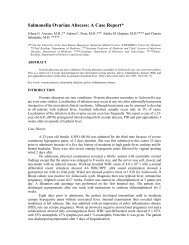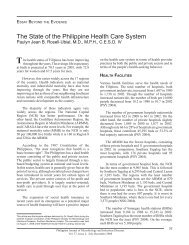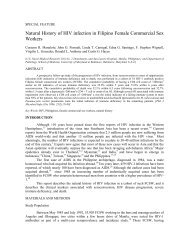The Philippine Clinical Practice Guideline on the Diagnosis and ...
The Philippine Clinical Practice Guideline on the Diagnosis and ...
The Philippine Clinical Practice Guideline on the Diagnosis and ...
Create successful ePaper yourself
Turn your PDF publications into a flip-book with our unique Google optimized e-Paper software.
symptoms first appear, may be recommended in well-instructed <strong>and</strong> highly educated patients<br />
(Grade A).<br />
3. Prophylaxis<br />
3.1 Indicati<strong>on</strong> for prophylaxis. Prophylaxis is recommended in women whose frequency of<br />
recurrence is not acceptable to <strong>the</strong> patient in terms of level of discomfort or interference with her<br />
normal activities. Prophylaxis may be withheld according to patient preference if <strong>the</strong> frequency of<br />
recurrence is tolerable to <strong>the</strong> patient (Grade C).<br />
3.2 Prophylactic strategy. If prophylaxis is to be given, ei<strong>the</strong>r of <strong>the</strong> following regimens is<br />
recommended: (1) c<strong>on</strong>tinuous prophylaxis, defined as <strong>the</strong> daily intake of a low dose of antiantibiotic,<br />
or 2) post-coital prophylaxis, defined as <strong>the</strong> intake of a single dose of antibiotic<br />
immediately after sexual intercourse (Grade A).<br />
3.3 Choice <strong>and</strong> dose of antibiotic. A number of antibiotics given c<strong>on</strong>tinuously for 6 m<strong>on</strong>ths have<br />
been proven to effectively reduce <strong>the</strong> number of episodes of UTI (See Table 5) (Grade A). Postcoital<br />
prophylaxis with a number of antibiotics has also been proven to be effective (see Table 5)<br />
(Grade A).<br />
Table 5. Antibiotics which have been proven to be effective in reducing <strong>the</strong> number of recurrences of UTI <strong>and</strong><br />
<strong>the</strong>ir recommended doses <strong>and</strong> regimens<br />
Recommended dose for c<strong>on</strong>tinuous prophylaxis Recommended Dose for post-coital prophylaxis<br />
Nitrofurantoin 100 mg at bedtime<br />
Norfloxacin 200 mg at bedtime 200 mg<br />
TMP/SMX 40 mg/200 mg at bedtime 40 mg/200 mg<br />
Ciprofloxacin 125 mg at bedtime 125 mg<br />
Ofloxacin 100 mg<br />
References: Pfau 1994, Staplet<strong>on</strong> 1990, Brumfitt 1991, Brumfitt 1995, Stamey 1977, Stamm 1980, Nicolle 1989,<br />
Melekos 1997<br />
3.4 Durati<strong>on</strong> of prophylaxis. Six-m<strong>on</strong>th c<strong>on</strong>tinuous or post-coital prophylaxis effectively reduces<br />
<strong>the</strong> number of UTI episodes (Grade A).<br />
3.5 Treatment of breakthrough infecti<strong>on</strong>s during prophylaxis. Breakthrough infecti<strong>on</strong>s during<br />
prophylaxis should he initially treated with any of <strong>the</strong> antibiotics recommended for<br />
uncomplicated cystitis o<strong>the</strong>r than <strong>the</strong> antibiotic being given for prophylaxis (Grade B). A urine<br />
culture should he requested <strong>and</strong> <strong>the</strong> treatment modified accordingly.<br />
4. Diagnostic work-up for urologic abnormalities.<br />
4.1 Indicati<strong>on</strong> for screening. Screening is not recommended for all patients (Grade E). Certain<br />
risk factors associated with a higher incidence of urologic abnormalities have been identified.<br />
Screening is recommended for patients with: (1) gross hematuria during a UTI episode; (2)<br />
obstructive symptoms; (3) clinical impressi<strong>on</strong> of persistent infecti<strong>on</strong>; (4) infecti<strong>on</strong> with ureasplitting<br />
bacteria; (5) history of pyel<strong>on</strong>ephritis; (6) history of or symptoms suggestive of<br />
urolithiasis; (7), history of childhood UTI; <strong>and</strong> (8) elevated serum creatinine (Grade C).<br />
4.2 Choice of screening procedure. A combinati<strong>on</strong> of a renal ultrasound <strong>and</strong> a plain abdominal<br />
radiograph is recommended (Grade B). Patients with anatomical abnormalities should he referred<br />
to a specialist (nephrologist or urologist) for fur<strong>the</strong>r evaluati<strong>on</strong> (Grade C).







